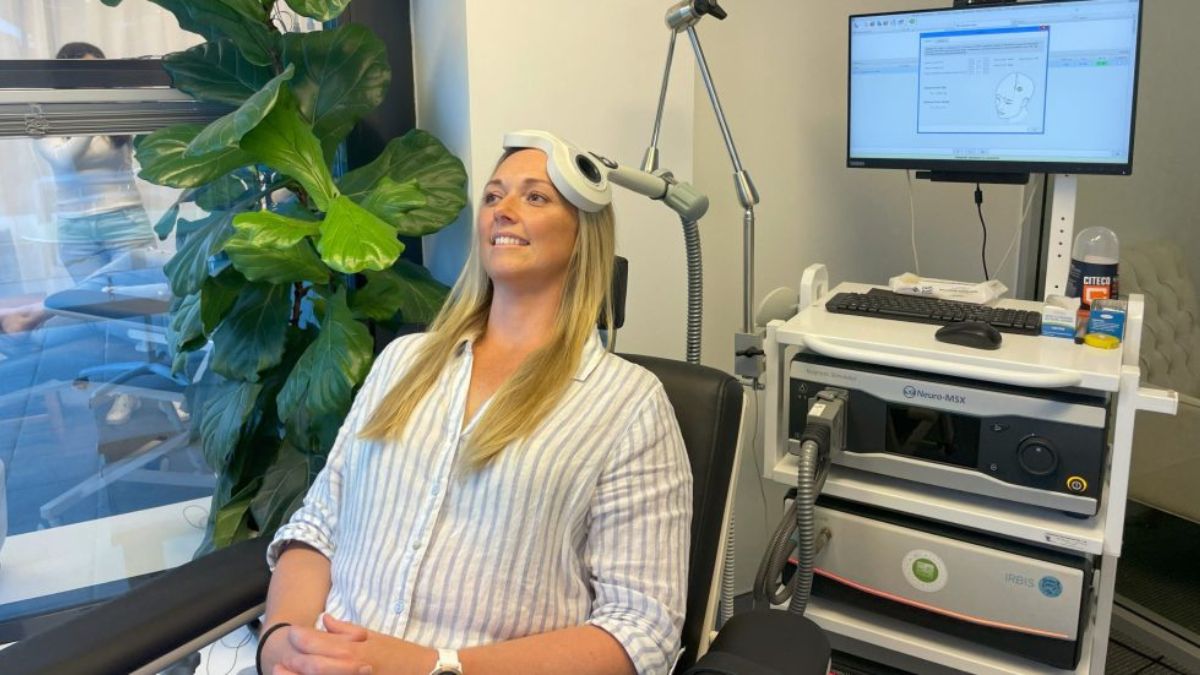HEALTH
Exploring the Benefits of TMS Treatment APN for Patients

Mental health care is evolving, and one of the most exciting advancements in this arena is TMS Treatment APN. This innovative approach harnesses technology to offer a new lease on life for those struggling with mental health issues. Imagine finding relief from conditions like depression or anxiety without the side effects often associated with traditional treatments. That’s just the beginning of what TMS Treatment APN can offer.
As we delve into this groundbreaking treatment, you’ll discover its inner workings, who it helps, and why advanced practice nurses are pivotal in delivering this therapy effectively. Whether you’re seeking options for yourself or a loved one or simply curious about emerging mental health solutions, you’re in the right place to explore how TMS Treatment APN could transform lives for the better. Let’s take a closer look at all that it has to offer!
What is TTMS Treatment APN and how does it work?
TMS Treatment APN, or Transcranial Magnetic Stimulation, is a non-invasive therapy designed to target areas of the brain associated with mood regulation. Using magnetic fields, it stimulates nerve cells to improve symptoms of various mental health conditions.
During a session, an electromagnetic coil is placed on the scalp. It delivers precise pulses that can activate brain regions involved in emotional processing and mood stability. Each treatment lasts about 20 to 40 minutes and typically occurs multiple times a week over several weeks.
What sets TMS apart from traditional therapies is its focus on neurological pathways without the need for medication. Patients often experience minimal discomfort during sessions and can resume normal activities immediately afterward. This innovative approach aims to provide lasting relief while reducing reliance on pharmaceuticals. The technology behind TMS reflects significant advancements in understanding how our brains work and how they can heal.
Common Conditions treated by TMS Treatment APN
TMS treatment APN offers a promising solution for various mental health disorders. One of the most common conditions treated is major depressive disorder. Patients who have not found relief from traditional medications often see significant improvement.
Anxiety disorders also respond well to TMS therapy. This includes generalized anxiety, panic disorders, and social anxiety. The non-invasive nature of TMS makes it an appealing option for those hesitant about more invasive treatments.
Obsessive-compulsive disorder (OCD) can be debilitating, but TMS has shown effectiveness in reducing symptoms. Many patients report a decrease in intrusive thoughts and compulsive behaviors after undergoing treatment.
Post-traumatic stress disorder (PTSD) is another area where TMS shines. Survivors of trauma often struggle with persistent distress; however, many find renewed hope through this innovative therapy.
Each condition presents unique challenges, yet TMS treatment APN provides tailored solutions that address individual patient needs effectively.
Benefits of TMS Treatment APN for patients
TMS treatment APN offers a range of benefits for patients seeking relief from mental health conditions. One of the most significant advantages is its non-invasive nature. Unlike traditional therapies, TMS does not require surgery or medication, minimizing potential side effects.
Patients often experience rapid results. Many report improvements within weeks, making it an appealing option for those tired of waiting for conventional treatments to take effect.
Additionally, TMS therapy targets specific brain areas involved in mood regulation. This focused approach can lead to more effective outcomes compared to generalized treatments.
Another benefit is the low risk associated with the procedure. Most patients tolerate TMS well and can continue their daily activities immediately after sessions without downtime.
Many individuals find that TMS complements other forms of treatment seamlessly. It enhances overall therapeutic effectiveness while providing a holistic pathway toward better mental wellness.
Who can benefit from TMS Treatment APN ?
TMS Treatment APN offers hope for a diverse range of individuals. Those struggling with major depressive disorder often find it particularly beneficial. Traditional therapies may not work for everyone, and TMS provides an alternative.
People dealing with anxiety disorders can also experience positive outcomes. The non-invasive nature of the treatment makes it appealing to those hesitant about medication or invasive procedures.
Moreover, patients battling PTSD have reported significant improvements through TMS. Its targeted approach helps in rewiring brain activity associated with traumatic memories.
Even individuals who face challenges related to obsessive-compulsive disorder (OCD) might see relief from symptoms after undergoing this therapy.
Essentially, anyone seeking a new avenue in their mental health journey could explore TMS Treatment APN as a promising option tailored to their needs.
The role of Advanced Practice Nurses (APNs) in providing TMS Treatment
Advanced Practice Nurses (APNs) play a crucial role in the administration of TMS treatment. Their extensive training equips them with the skills necessary to assess patients and develop tailored care plans.
As specialized professionals, APNs understand the complexities of mental health disorders. They provide comprehensive evaluations to determine if TMS is an appropriate treatment option for individuals.
Once therapy begins, APNs monitor patient progress closely. They adjust treatment protocols as needed, ensuring that each session maximizes effectiveness while minimizing discomfort.
Moreover, they serve as valuable educators for patients. By explaining how TMS works and what to expect during sessions, they alleviate anxiety and foster trust in the process.
The collaboration between APNs and other healthcare providers strengthens the overall approach to patient care. This teamwork enhances outcomes and promotes a holistic understanding of mental health treatments like TMS.
Patient success stories with TMS Treatment APN
Many patients have found hope through TMS Treatment APN. Stories abound of individuals who once struggled with severe depression and anxiety, now thriving after their sessions.
One patient shared how she felt trapped in her own mind for years. Traditional therapies yielded little relief. After starting TMS Treatment APN, she experienced a significant shift within weeks. The darkness that overshadowed her life began to lift.
Another man spoke about his long battle with PTSD. He described feeling hopeless before discovering this innovative treatment method. With each session, he noticed improvements in his mood and overall outlook on life.
These personal journeys highlight the transformative power of TMS Treatment APN. Each story reflects resilience and the possibility of recovery, offering inspiration to those still seeking help in their mental health journey.
Future potential of TMS Treatment APN and its impact on mental health care
The future of TMS Treatment APN looks promising as mental health care evolves. Researchers are continually exploring its applications, aiming to broaden the spectrum of conditions it can address effectively.
As technology advances, we may see innovations like personalized treatment protocols tailored to individual patients’ needs. This could enhance efficacy and minimize side effects significantly.
With increasing acceptance in the medical community, there’s potential for insurance coverage expansion. Greater access to TMS Treatment APN would make this therapy a viable option for more patients struggling with mental health issues.
Educational initiatives are also on the rise. As awareness grows about what TMS Treatment APN entails, more healthcare providers will be equipped to offer these services confidently.
Such progress indicates a shift towards integrating non-invasive therapies into standard mental health care practices. The emphasis on holistic approaches is likely to redefine how we treat psychological disorders moving forward.
Conclusion
TMS Treatment APN represents a significant advancement in mental health care, offering patients a powerful alternative to traditional therapies. With its non-invasive approach and growing body of supportive research, it’s clear that many individuals can find relief through this innovative treatment. By addressing various conditions effectively, TMS opens doors for those who have struggled with conventional methods.
The role of Advanced Practice Nurses (APNs) is crucial in administering and overseeing these treatments. Their expertise ensures that patients receive tailored care throughout the process. Hearing success stories from real patients reinforces the potential of TMS Treatment APN as a life-changing option.
As we look forward to what lies ahead, the future for TMS Treatment APNs shines brightly within the realm of mental health care. Continued advancements and further understanding could pave the way for even more effective applications, ensuring that countless individuals gain access to better mental wellness solutions. The journey towards improved mental health is ongoing, but TMS Treatment APN stands out as an empowering tool on this path.
HEALTH
Top Treatments for Rosacea: Effective Solutions for Clearer Skin

Rosacea is a chronic skin condition that can lead to redness, visible blood vessels, and even acne-like breakouts. While it’s common, managing it effectively requires the right treatment plan. From dermatologist-recommended therapies to soothing skincare ingredients, here’s how you can achieve calmer, clearer skin.
Top Dermatologist-Recommended Treatments for Rosacea
- Topical Medications
Dermatologists often prescribe topical treatments such as metronidazole, ivermectin, or azelaic acid. Azelaic acid, in particular, is highly effective in reducing inflammation and redness while improving overall skin texture. It’s gentle enough for daily use and helps minimize flare-ups when used consistently. - Laser and Light Therapy
For persistent redness or visible blood vessels, laser treatments like intense pulsed light (IPL) can be a game-changer. These treatments target and reduce vascular lesions, giving your skin a more even tone. - Oral Medications
In cases of severe rosacea, oral antibiotics or isotretinoin may be prescribed to control inflammation and prevent breakouts. Consult your dermatologist to determine if this is the right option for you. - Skincare Adjustments
Incorporating rosacea skincare products into your routine can significantly improve your skin’s health. Look for gentle, fragrance-free products designed specifically for sensitive skin to prevent irritation.
Skincare Ingredients that Help with Rosacea
- Azelaic Acid
Azelaic acid is a standout ingredient for managing rosacea. It helps reduce redness, inflammation, and the appearance of post-inflammatory pigmentation. Regular use of an azelaic acid cream can soothe irritated skin and promote a clearer complexion. - Niacinamide
Known for its calming properties, niacinamide helps strengthen the skin barrier, reduce redness, and improve overall skin hydration. It’s a versatile ingredient that complements any rosacea-friendly routine. - Ceramides
Rosacea-prone skin often has a compromised barrier, leading to increased sensitivity. Ceramides help restore and protect this barrier, keeping irritants out and locking moisture in. - Hyaluronic Acid
Hydration is key for managing rosacea. Hyaluronic acid attracts and retains moisture without causing irritation, making it an excellent choice for maintaining balanced skin. - Supplements for Overall Skin Health
While managing rosacea externally is important, addressing your body’s internal health can also make a difference. Nutritional deficiencies can exacerbate skin issues, so consider incorporating the best vitamins for hair growth and overall skin health into your routine. When your body is nourished, it often reflects in a healthier complexion.
Final Thoughts
Dealing with rosacea can feel overwhelming, but with the right treatments and skincare products, you can significantly reduce symptoms and regain your confidence. Whether it’s trying azelaic acid, consulting a dermatologist for advanced therapies, or using rosacea skincare products, consistency and care are key. For a comprehensive approach, always pair your external efforts with internal nourishment to achieve lasting results.
HEALTH
How PFAS Water Contamination Can Lead to Cancer: Understanding Your Legal Options

In recent years, the harmful effects of PFAS (per- and poly-fluoroalkyl substances) have gained significant attention, particularly regarding water contamination. These substances, often called “forever chemicals,” are known for their persistence in the environment and human bodies. Unfortunately, long-term exposure to PFAS has been linked to serious health issues, including cancer. As a result, individuals living in areas with contaminated water sources may face heightened risks. Many are now pursuing a PFAS cancer water contamination lawsuit to understand their legal options for seeking justice and compensation. For general personal injury assistance, visit https://marquislawgroup.com/.
What is PFAS?
PFAS are a group of synthetic chemicals used in a variety of industrial and consumer products due to their water—and stain-resistant properties. These substances are commonly found in nonstick cookware, waterproof clothing, firefighting foam, food packaging, and even some water-repellent fabrics.
Unfortunately, this durability also means PFAS can accumulate over time in water sources, soil, air, and even the human body.
How Does PFAS Contamination Occur in Water?
PFAS can enter water supplies through various sources, including industrial discharges, the use of firefighting foam at airports or military bases, and improper disposal of PFAS-containing products. Once these chemicals reach water sources, they can persist for years, affecting drinking water quality in surrounding communities. Municipal water systems, private wells, and surface water bodies are vulnerable to PFAS contamination.
While PFAS contamination is often associated with specific industrial sites or military installations, it can also spread more broadly due to the chemicals’ persistence in the environment. People living near these contaminated water sources are at an increased risk of exposure, mainly if they rely on untreated healthy water or live in communities where the local water supply is not regularly tested for PFAS.
Health Risks of PFAS Exposure
PFAS exposure is linked to numerous health problems, including:
- Cancer:
Research has shown a significant connection between long-term PFAS exposure and certain types of cancer, including kidney and liver cancer. People exposed to high levels of PFAS, particularly those living near contaminated water sources, may have a higher risk of developing these cancers.
- Cholesterol and Liver Problems:
Studies have also shown that PFAS can raise cholesterol levels and cause liver damage.
- Pregnancy Complications:
Pregnant women exposed to PFAS may be at a higher risk of complications, including preeclampsia, low birth weight, and developmental delays in their children.
Because of these health risks, people exposed to PFAS through contaminated water may be eligible for compensation through legal avenues.
Can PFAS Exposure Lead to Cancer?
Yes, long-term exposure to PFAS is associated with an increased risk of developing certain cancers. The chemicals accumulate in the body over time, and as they build up, they can cause various health issues.
In addition to kidney and liver cancer, some studies suggest a potential link to other cancers, such as testicular cancer and bladder cancer.
Because of the strong association between PFAS exposure and cancer, individuals who live in contaminated areas may want to seek legal advice if they or a loved one have developed cancer.
Legal Options for Victims of PFAS Contamination
Suppose you or a loved one has been diagnosed with cancer or another health condition linked to PFAS exposure. In that case, it’s essential to understand your legal rights. Here are some potential legal options for victims of PFAS water contamination:
1. Personal Injury Lawsuit
A personal injury lawsuit may be an option for people who have been harmed because of PFAS contamination. In these cases, plaintiffs must prove that their exposure to PFAS directly caused their health issues, such as cancer. Personal injury lawsuits can be filed against responsible parties, including companies that released PFAS into water sources or government agencies that failed to regulate the chemicals properly.
In some cases, the responsible party may also have to pay extra damages as a punishment.
2. Class Action Lawsuit
Suppose a large group of people has been exposed to PFAS and developed similar health issues. In that case, a class action lawsuit may be an effective legal option. In class actions, a group of plaintiffs collectively sues the defendant, and any compensation awarded is distributed among the class members. These lawsuits can be particularly useful in cases where the number of people affected by PFAS contamination is significant, as they allow individuals to join together in a single legal action.
3. Environmental Litigation
Environmental litigation focuses on holding these companies accountable for their role in the contamination. This type of lawsuit often seeks compensation for cleanup costs, environmental damage, and harm to public health. Ecological lawsuits can be filed by government agencies or private individuals affected by the contamination.
4. Workers’ Compensation Claims
Workers’ compensation benefits may be available for people who were exposed to PFAS at work, like firefighters who used PFAS foam. These benefits help cover medical bills, lost wages, and other costs related to job injuries or illnesses. Workers who develop cancer or health issues from PFAS exposure may qualify for these benefits.
5. Regulatory Complaints
In addition to private legal action, individuals affected by PFAS contamination can file complaints with regulatory agencies such as the EPA or state environmental departments. While regulatory agencies cannot offer direct compensation, they can investigate the contamination, enforce environmental laws, and require responsible parties to clean up polluted water sources.
Conclusion
PFAS water contamination is a serious public health issue, and individuals who have been exposed to these harmful chemicals may face an increased risk of cancer and other health problems. Suppose you or a loved one has been diagnosed with cancer or other conditions related to PFAS exposure. In that case, it’s essential to understand your legal rights and explore potential legal options for seeking justice and compensation.
Whether through a personal injury lawsuit, class action, or environmental litigation, victims of PFAS contamination have avenues to hold responsible parties accountable.
By taking legal action, individuals seek justice for themselves and help raise awareness of the dangers of PFAS contamination, potentially leading to broader regulatory changes to protect public health.
HEALTH
How to Effectively Use Recuperbate for Enhanced Well-Being

In today’s fast-paced world, finding ways to enhance our well-being is more important than ever. Whether it’s stress relief, improved sleep quality, or simply a boost in energy, we are constantly on the lookout for effective solutions. Enter Recuperbate—a unique blend of natural ingredients designed to support your mind and body. But what exactly is it? How can it fit into your daily routine? If you’re curious about this innovative product and its potential benefits, you’re in the right place. Let’s dive deeper into how Recuperbate could become an essential part of your wellness journey!
What is Recuperbate and How Does it Work?
Recuperbate is a wellness supplement crafted from a blend of natural ingredients aimed at supporting both physical and mental health. It combines adaptogens, vitamins, and minerals that work synergistically to promote relaxation and recovery.
The magic lies in its ability to help the body manage stress more effectively. By targeting cortisol levels, Recuperbate can assist in reducing anxiety while enhancing your overall mood.
Additionally, it supports sleep cycles by promoting deeper rest without the grogginess often associated with traditional sleep aids. This allows you to wake up feeling refreshed and ready for the day ahead.
With regular use, Recuperbate may also improve energy levels throughout the day. It’s not just about relaxation; it’s about balance—helping you feel grounded amidst life’s challenges.
The Benefits of Using Recuperbate
Recuperbate offers a range of benefits that can enhance your overall well-being. One of its primary advantages is stress reduction. Many users report feeling more relaxed and at ease after incorporating it into their routines.
Another significant benefit is improved sleep quality. People often struggle with restless nights, but recuperbate may help create a calming effect, making it easier to drift off.
Enhanced focus is another perk worth mentioning. Users have noted increased mental clarity and productivity during the day, allowing them to tackle tasks more efficiently.
Additionally, recuperbate supports physical recovery after exercise or strenuous activities. It helps alleviate muscle soreness and promotes faster healing.
Some users appreciate the boost in mood they experience while using recuperbate. Its holistic approach contributes positively to emotional health as well, making it a valuable addition to daily life.
How to Incorporate Recuperbate into Your Daily Routine
Incorporating recuperbate into your daily routine can be seamless and rewarding. Start by setting a specific time for its use—perhaps in the morning or before bed. This consistency helps establish a habit.
Mix recuperbate with your favorite beverage. Whether it’s hot tea, smoothies, or plain water, find what works best for you. Experiment with different flavors to keep things interesting.
Consider creating a ritual around your recovery time. Light some candles or play calming music while you enjoy your drink. This sets a relaxing atmosphere that enhances the experience.
If you’re busy during the day, try using recuperbate during breaks at work. Take moments to unwind and recharge throughout your hectic schedule.
Track how you feel after incorporating it into your routine. Keeping notes will help identify which times are most effective for you to reap all those benefits!
Tips for Maximizing the Effects of Recuperbate
To truly maximize the effects of recuperbate, timing is key. Consider taking it at times when your body needs support most, such as after intense workouts or during periods of stress.
Hydration plays a crucial role too. Drinking enough water throughout the day helps enhance its benefits and keeps you feeling energized.
Pairing recuperbate with a balanced diet can also amplify its impact. Foods rich in antioxidants and omega-3 fatty acids complement its restorative properties beautifully.
Establishing a consistent routine fosters familiarity and effectiveness. Try to incorporate recuperbate into your daily schedule so that it becomes part of your self-care ritual.
Listen to your body’s responses. Adjust dosages or timing based on how you feel for optimal results, ensuring that you get the most out of this wellness aid.
Potential Side Effects and Precautions
While Recuperbate offers numerous benefits, it’s important to be aware of potential side effects. Some users may experience mild digestive discomfort or headaches during the initial stages of use. These symptoms generally subside as your body adjusts.
Allergic reactions are rare but possible. If you notice skin rashes or unusual swelling, discontinue use and consult a healthcare professional immediately.
Pregnant or nursing individuals should approach Recuperbate with caution. It’s always wise to seek advice from a doctor before starting any new supplement.
Interactions with certain medications can occur as well. If you’re on prescription drugs, check with your pharmacist or doctor to ensure safety and compatibility.
Listening to your body is crucial when introducing something new. Prioritize your health by keeping track of how you feel after using Recuperbate for the first time.
User Testimonials and Success Stories
Many users have shared their transformative experiences with recuperbate. One individual described how it significantly improved their sleep quality, noting they felt more rested and energized during the day.
Another user highlighted its positive impact on stress levels. They found that incorporating recuperbate into their routine helped them manage anxiety better, allowing for clearer thinking and greater productivity.
A fitness enthusiast reported enhanced recovery times after workouts. They noticed less muscle soreness and quicker return to their normal routines when using this product regularly.
These personal stories illustrate the diverse benefits of recuperbate, showcasing its potential in various aspects of life—from mental clarity to physical recovery. Each testimonial adds a unique perspective on how this innovative solution can support well-being in different ways.
Conclusion: Why You Should Give Recuperbate a Try
Recuperbate is proving to be a valuable tool for those seeking enhanced well-being. With its unique formulation designed to support recovery and relaxation, it can fit seamlessly into your life. The benefits are numerous, from improved sleep quality to reduced stress levels.
Users have shared remarkable success stories that highlight the transformative effects of incorporating Recuperbate into their routines. You don’t just hear about it; you feel it in your daily experiences—whether it’s waking up refreshed or simply feeling more balanced throughout the day.
If you’re on the fence about trying Recuperbate, consider what you stand to gain: better overall health and an improved sense of vitality. Embracing this new addition could very well lead you down a path toward greater wellness and happiness.
-

 TOPIC11 months ago
TOPIC11 months agoTop 10 Gift Cards in Romania: A Complete Guide
-

 TECHNOLOGY11 months ago
TECHNOLOGY11 months agoLync Conf Mods You Should Install Today for Better Meetings
-

 TECHNOLOGY1 year ago
TECHNOLOGY1 year agoUnveiling Sifangds: The Future of Digital Innovation
-

 TOPIC11 months ago
TOPIC11 months agoPuppygirlxd: A Case Study in Modern Identity and Expression
-

 TECHNOLOGY11 months ago
TECHNOLOGY11 months agoWhy Plutoscreen. com/ is Revolutionizing Online Experiences
-

 TOPIC12 months ago
TOPIC12 months ago8 Energy-Efficient Basement Renovation Tips for a Sustainable Space
-

 TECHNOLOGY11 months ago
TECHNOLOGY11 months agoWhy SeveredBytes.net/ is Your Next Go-To Resource for Tech Insights
-

 TOPIC10 months ago
TOPIC10 months agoHow Eolaneday.iday is Shaping Modern Social Connections
